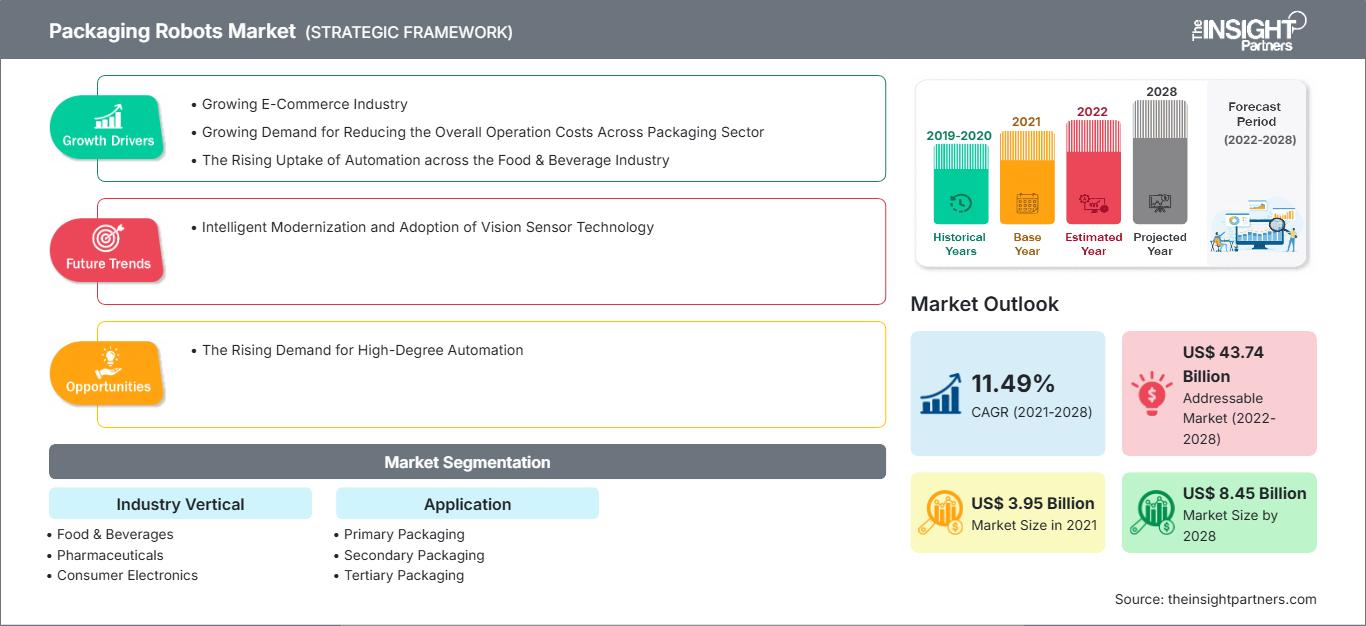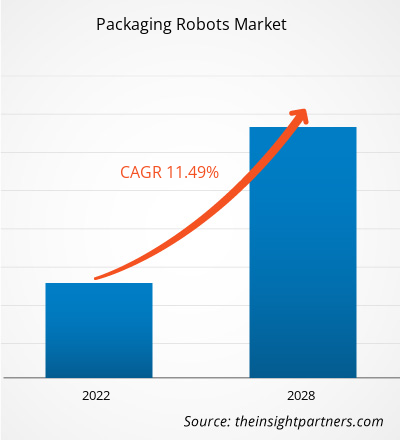[연구 보고서] 포장 로봇 시장은 2021년 39억 4,543만 달러에서 2028년 84억 4,821만 달러로 성장할 것으로 예상되며, 2021년부터 2028년까지 연평균 성장률(CAGR) 11.49%로 성장할 것으로 예상됩니다.
분석가 관점:
포장 로봇은 자재 취급 작업에 정확성, 속도, 그리고 생산성을 제공하며, 이로 인해 다양한 제조업체들이 처리량 향상을 위해 포장 로봇을 도입하고 있습니다. 또한, 포장 로봇은 한 번에 더 많은 제품을 들어 올릴 수 있어 수동 작업보다 가동 시간이 훨씬 길고, 인건비 및 전반적인 운영 비용 절감 효과를 제공하여 포장 로봇 시장 성장을 촉진합니다. 또한, 식음료 산업에서 수백 개의 포장재와 병을 채우고 기타 복잡한 작업을 인간보다 더 효율적으로 수행하는 협업 로봇의 사용이 증가함에 따라 포장 로봇 시장 성장이 가속화되고 있습니다. 또한, 전 세계적으로 성장하는 전자상거래 산업 또한 포장 로봇 시장 성장을 촉진하는 또 다른 요인입니다. 더욱이, 고도 자동화에 대한 수요 증가는 예측 기간 동안 포장 로봇 시장 성장의 기회를 창출할 것으로 예상됩니다.
시장 개요:
포장 로봇은 다양한 보관 위치에서 물건을 집어 선반에 놓기 위해 미리 정의된 경로를 따라 이동하도록 프로그래밍된 로봇입니다. 이러한 로봇은 인간의 도움 없이 작동하며 생산 라인을 간소화하고 과도한 인간의 개입을 줄임으로써 시간을 절약하는 데 도움이 될 수 있습니다. 이 로봇은 속도, 정확성, 생산성을 제공하는 동시에 올바르게 배치될 경우 비교적 빠른 투자 수익률(ROI)을 달성하여 다양한 산업 분야에 걸쳐 많은 중요한 이점을 제공합니다. 포장 로봇은 최종 작업 도구(EOAT)에 따라 다양한 작업을 수행할 수 있습니다. 포장 로봇은 대부분 제품 포장을 개봉, 충전, 운반, 팔레트 적재, 밀봉, 코드화 및 라벨링하는 용도로 설계되었습니다. 이러한 장점 덕분에 제품의 무결성을 보호하기 위해 정확하고 일관되며 고품질로 포장해야 하는 산업 분야에서 가장 많이 사용됩니다. 산업 분야에서는 포장 사이클 시간을 단축하고 생산성을 향상시키기 위해 포장 로봇을 많이 사용하며, 식음료 산업에서도 비슷한 이유로 포장 로봇을 사용합니다.
요구 사항에 맞게 이 보고서를 사용자 정의하십시오.
이 보고서의 일부, 국가 수준 분석, Excel 데이터 팩을 포함하여 모든 보고서에 대한 사용자 정의를 무료로 받을 수 있을 뿐만 아니라 스타트업 및 대학을 위한 훌륭한 제안 및 할인을 이용할 수 있습니다
포장 로봇 시장: 전략적 통찰력

-
이 보고서의 주요 주요 시장 동향을 확인하세요.이 무료 샘플에는 시장 동향부터 추정 및 예측에 이르기까지 데이터 분석이 포함됩니다.
포장 로봇 시장 성장 동력:
식음료 산업 전반의 자동화 도입 증가가 포장 로봇 시장 성장을 견인하고 있습니다.
식음료 산업의 자동화는 검사, 포장, 보관 등 다양한 생산 공정에 걸쳐 기술을 통합하는 것을 의미합니다. 지난 수년간 식음료 회사들은 다양한 규제 기관에서 정한 식품 안전 및 품질 기준을 충족하고 생산 현장의 전반적인 인건비를 절감하기 위해 무인 운반 차량, 델타 로봇, 로봇 팔과 같은 자동화 시스템을 통합하여 다양한 생산 공정을 최적화해 왔습니다.
또한, 포장된 식음료는 높은 정확도와 반복적인 포장 공정을 필요로 하는데, 이는 사람에게는 어려운 과제입니다. 이러한 요인으로 인해 1차 및 2차 포장, 팔레타이징을 포함한 다양한 활동에 로봇 기술에 대한 수요가 증가하고 있습니다. 또한, 비전 가이드 로봇은 빈 피킹, 병 취급, 트레이 적재와 같은 다양한 반복 작업을 효율적으로 완료할 수 있어 식음료 부문 전반에 걸쳐 수요가 증가하고 있습니다. 또한, 효율성 향상, 추적성 향상, 높은 유연성을 포함한 수많은 이점으로 인해 식음료 산업의 자동화 필요성이 높아지고 있습니다. 이러한 요인들은 식음료 생산업체가 생산 시설 전반에 자동화 기술 통합에 대한 투자를 늘리도록 장려하고 있습니다. 예를 들어, 2021년 미국 스낵 브랜드인 Utz Brands Inc.는 전체 운영 비용 절감을 위해 생산 공장 전반에 자동화 솔루션을 통합할 계획을 발표했습니다. 마찬가지로, 2022년 Hormel Foods 또한 생산 시설 전반에 자동화를 도입할 계획을 발표했습니다. Tyson Foods와 Cargill Inc.와 같은 다른 식음료 브랜드들도 자동화 기술 도입을 위해 노력하고 있습니다. 따라서 식음료 산업 전반에 자동화에 대한 투자가 증가하고 있습니다. 음료 산업이 포장 로봇 시장 성장을 촉진하고 있습니다.
세분화 분석:
산업 분야별로 포장 로봇 시장은 식음료, 제약, 가전 등으로 세분화됩니다. 식음료 부문은 2021년 시장 점유율이 가장 높았으며, 제약 부문은 2021년부터 2028년까지 가장 높은 연평균 성장률을 기록할 것으로 예상됩니다. 식음료 산업은 자동화 솔루션의 빠른 통합을 경험하고 있습니다. 포장 로봇은 품질 관리를 보장하는 동시에 포장 속도를 향상시킵니다. 포장 로봇 통합은 작업자 안전을 강화하고, 종단 간 추적성을 통해 생산량, 폐기물 감소, 인건비를 증가시켜 생산 유연성을 높입니다. 이러한 이점을 바탕으로 여러 식품 회사는 비전 가이드 로봇 팔, 무인 운반 차량, 델타 로봇, 고급 검사 시스템을 활용하여 식품 안전 및 품질 기준을 보장하고 끊임없이 증가하는 수요를 충족하기 위한 공정 최적화에 힘쓰고 있습니다. 따라서 식음료 산업에서 기존 인프라를 업그레이드하기 위한 자동화 도입이 증가하면서 시장 성장이 가속화되고 있습니다.
지역 분석:
아시아 태평양 지역은 예측 기간 동안 포장 로봇 시장에서 상당한 성장을 보일 것으로 예상됩니다. 이 지역에서 중국은 2021년에 가장 큰 시장 점유율을 차지할 것이며, 인도는 2021년부터 2028년까지 가장 높은 연평균 성장률을 기록할 것으로 예상됩니다. 생산성 향상 및 비용 절감을 위한 자동화 투자 증가는 제조업체가 증가하는 소비자 수요를 충족하는 데 도움이 되고 있습니다. 또한, 로봇 통합은 포장 효율성을 높이고 운영 비용을 절감하는 데 도움이 되므로 다양한 산업 분야에서 수요가 증가하고 있습니다. 또한, 이 지역의 활발한 전자상거래 산업이 자동화 수요를 견인하고 있습니다. 국제항공운송협회(IATA)에 따르면, 아시아 태평양 지역은 전 세계 전자상거래 시장 성장을 주도하고 있으며, 중국은 이 성장에서 상당한 비중을 차지하고 있습니다. 국제무역청(ITA)에 따르면 중국의 전자상거래 시장은 세계 최대 규모이며 전 세계 거래량의 거의 50%를 차지합니다. 마찬가지로 아시아 태평양 지역의 다른 국가들의 전자상거래 시장도 상당한 성장을 보이고 있습니다. 예를 들어, 국제무역청(ITA)에 따르면 세계 11위의 전자상거래 시장인 호주의 규모는 2024년까지 323억 달러에 이를 것으로 예상됩니다. 인도 브랜드 자산 재단(IBEF)에 따르면 인도의 전자상거래 시장은 2025년까지 1,880억 달러에 이를 것으로 예상됩니다. 따라서 자동화 및 전자상거래 산업의 성장은 아시아 태평양 지역 시장 성장을 촉진하고 있습니다.
주요 기업 분석:
ABB Ltd, Brenton Engineering, FANUC Corporation, Krones AG, KUKA Roboter GmbH, Mitsubishi Electric Corporation, Remtec Automation LLC, Robert Bosch GmbH, Schnider Electric, Yaskawa America는 주요 포장 로봇 시장 참여 기업입니다. 이러한 포장 로봇 시장 참여 기업은 지속적인 제품 개발과 혁신에 집중하고 있습니다.
포장 로봇 시장 지역별 통찰력
The Insight Partners의 분석가들은 예측 기간 동안 포장 로봇 시장에 영향을 미치는 지역별 동향과 요인을 면밀히 분석했습니다. 이 섹션에서는 북미, 유럽, 아시아 태평양, 중동 및 아프리카, 그리고 중남미 지역의 포장 로봇 시장 부문 및 지역별 현황도 다룹니다.
포장 로봇 시장 보고서 범위
| 보고서 속성 | 세부 |
|---|---|
| 시장 규모 2021 | US$ 3.95 Billion |
| 시장규모별 2028 | US$ 8.45 Billion |
| 글로벌 CAGR (2021 - 2028) | 11.49% |
| 이전 데이터 | 2019-2020 |
| 예측 기간 | 2022-2028 |
| 다루는 세그먼트 |
By 산업 분야
|
| 포함된 지역 및 국가 |
북미
|
| 시장 선도 기업 및 주요 회사 프로필 |
|
포장 로봇 시장 참여자 밀도: 비즈니스 역학에 미치는 영향 이해
포장 로봇 시장은 소비자 선호도 변화, 기술 발전, 그리고 제품의 장점에 대한 인식 제고 등의 요인으로 인한 최종 사용자 수요 증가에 힘입어 빠르게 성장하고 있습니다. 수요가 증가함에 따라 기업들은 제품 및 서비스 확장, 소비자 니즈 충족을 위한 혁신, 그리고 새로운 트렌드를 적극 활용하고 있으며, 이는 시장 성장을 더욱 가속화하고 있습니다.

- 을 얻으세요 포장 로봇 시장 주요 주요 플레이어 개요
최근 동향:
제품 출시, 파트너십, 협업, 인수합병과 같은 비무기적 및 유기적 전략은 시장에서 기업들이 적극적으로 채택하고 있습니다. 이러한 기업들의 최근 주요 시장 동향은 다음과 같습니다.
- 2023년 4월, Shemesh는 화장품용 완전 로봇 강화 포장 라인 TKS-C60 출시를 발표했습니다. 이 라인은 모든 형태와 크기의 화장품을 공급, 충전, 캡핑, 라벨링, 케이스 포장, 팔레타이징하는 전체 포장 공정을 처리하도록 설계되었습니다. TKS-C60은 크림, 파운데이션부터 향수, 매니큐어까지 다양한 제품의 분당 60병의 속도로 원활하고 중단 없는 병입 라인을 보장합니다.
- 2023년 3월, 맞춤형 병입 및 포장 산업 자동화 시스템 제조업체인 Proco Machinery는 포장 산업의 인력 부족 문제 해결을 위해 새로운 협동 로봇 포장기 출시를 발표했습니다. 이 새로운 Proco 협동 로봇 포장기는 인간 작업자와 함께 작업하여 효율성과 성능을 향상시키도록 설계되었습니다. 이 새로운 로봇 포장기는 용기 테스트부터 케이스 포장까지 다양한 작업을 수행할 수 있습니다.
- 2023년 2월, Rapid Robotics는 Universal Robots(UR)와 새로운 파트너십을 발표했습니다. 이 파트너십을 통해 덴마크 협동 로봇(코봇) 제조업체인 Universal Robots는 Rapid Robotics의 북미 전역에 협동 로봇 작업 셀을 구축하는 데 필요한 협동 로봇 팔을 공급할 예정입니다. 또한, 유니버설 로봇은 Rapid Robotics가 전국적인 사업 영역을 확장하는 동시에 더 많은 고객에게 서비스를 제공하고 기대해 온 빠른 구축 시간을 유지할 수 있도록 지원할 것입니다. 이러한 협동 로봇은 팔레타이징, 상자 제작 및 포장, 그리고 더 무거운 페이로드나 더 긴 작업 반경을 필요로 하는 작업 등 다양한 기능을 갖추고 있습니다.
- 2022년 11월, 전자상거래용 AI 기반 로봇 분야의 글로벌 선두 기업인 OSARO는 전자상거래 및 물류 기업을 위한 픽앤플레이스 로봇 시스템 통합을 가속화하기 위해 SVT Robotics와 파트너십을 체결했다고 발표했습니다. SVT Robotics의 획기적인 SOFTBOT 플랫폼을 통해 기업은 필요한 로봇, 자동화 및 IoT 장치를 단 며칠 또는 몇 주 만에 통합하고 구축할 수 있습니다. 이번 계약의 일환으로 SVT Robotics는 OSARO의 파트너 프로그램에 가입했습니다. 이 프로그램은 물류 처리 작업에 로봇 솔루션을 도입하려는 기업에 원스톱 서비스를 제공합니다.
- 2022년 7월, ABB는 IRB 365를 통해 FlexPicker Delta 로봇 포트폴리오를 확장한다고 발표했습니다. 5축과 1.5kg의 가반하중을 갖춘 IRB 365는 쿠키, 초콜릿, 고추, 사탕, 소형 병, 소포 등 포장된 경량 제품의 방향 전환에 유연하면서도 동급 최고 속도를 자랑합니다. 전자상거래 증가와 즉시 사용 가능한 포장 제품에 대한 수요 증가에 대응하여, IRB 365는 생산 라인 속도와 적응성이 필수적인 식음료, 제약, 소비재 등의 분야에 적합하도록 개발되었습니다.
- 과거 분석(2년), 기준 연도, CAGR을 포함한 예측(7년)
- PEST 및 SWOT 분석
- 시장 규모 가치/거래량 - 글로벌, 지역, 국가
- 산업 및 경쟁 환경
- Excel 데이터세트
최근 보고서
사용 후기
구매 이유
- 정보에 기반한 의사 결정
- 시장 역학 이해
- 경쟁 분석
- 고객 인사이트
- 시장 예측
- 위험 완화
- 전략 기획
- 투자 타당성 분석
- 신흥 시장 파악
- 마케팅 전략 강화
- 운영 효율성 향상
- 규제 동향에 발맞춰 대응






















 무료 샘플 받기 - 포장 로봇 시장
무료 샘플 받기 - 포장 로봇 시장